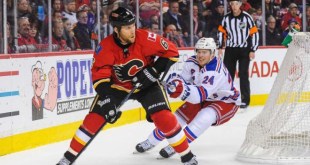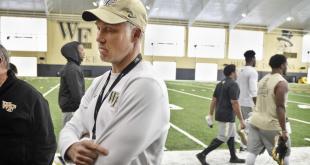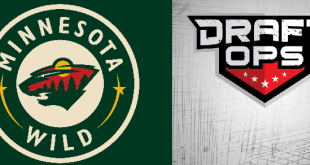For anyone not living under a rock in the hockey world, Dennis Wideman was suspended for 20 games after what looked like a brutal hit on linesman Don Henderson.[i] It occurred immediately after receiving a resounding check into the boards himself, after which Wideman was visibly shaken up. The NHLPA is set to appeal on his behalf, having released a statement pointing to the medical evidence that Wideman was concussed, as well as having no prior conduct issues over his long career. The crux of this appeal is whether or not Wideman met the tenets of Rule 40.2 regarding physical abuse of officials.
Under Rule 40, a mandatory 20-game suspension is required in the event “[a]ny player who deliberately strikes an official and causes injury or who deliberately applies physical force in any manner against an official with intent to injure, or who in any manner attempts to injure an official.”[ii] The next level (40.3 – 10-game mandatory suspension) involves applying physical force to, or spitting on, an official without intent to injure. As part of 40.2, the NHL defines intent to injure as “any physical force which a player knew or should have known could reasonably be expected to cause injury.”
The NHL makes note of the fact that Wideman’s stick was brought up while approaching Henderson from behind before cross-checking, he did not appear to have any issues skating off the ice, and signaled the bench for a line change while skating. The league also notes that Wideman refused immediate medical attention, instead staying in the game.[iii] From any normal standpoint, all of these factors would seem to indicate Wideman was in his right mind, knew what he was doing, and had a relatively vicious lapse of judgment. In this instance, no matter how squeaky clean Wideman has been throughout his career to date, it would not save him from the mandatory 20-game suspension. The problem that muddies the waters of Wideman’s suspension is the diagnosed concussion as a result of the hit from Miikka Salomaki.
The NHL doesn’t receive the same level of attention as the NFL’s concussion drama, but the issue has definitely gained steam in the past year. In addition to lawsuits being brought, stories have been arising regarding what the NHL has known about concussions and how closely (or not) concussion protocol is followed. The league is put in a difficult spot by Wideman’s suspension; if they recognize that a concussed Wideman was not fully cognizant of his actions, they will be taking an inadvertent stance that gets away from the protection of officials. Currently, especially in light of Wideman’s initial suspension, the league essentially takes a bright-line position on physical contact with officials. If a player hits a linesman, and reasonably understands that he could be injured by the action, then 20 games it is. Typically this stance would be admirable in that there should never be a reason to physically engage the officials in such a manner. The problem is the current wording of Rules 40.2 and 40.3, and how it applies to a concussed Wideman.
40.2 relates to “deliberate” hits with “intent to injure.” Wideman hits Henderson within 15 seconds of getting crushed by Salomaki. Regardless of his denial of immediate medical attention (show me any athlete who won’t attempt to stay in the game, Alvaro Pereira comes to mind) the fact is that Dennis Wideman was diagnosed with a concussion. One of the ever-present problems with concussions is the uncertainty regarding the level of damage done, from person to person or even from one concussion to another. While the NHL points out that Wideman seemed to possess his faculties once he started skating towards the bench, it is hard to ignore the slumped, head-down Wideman that comes off the boards. Yes he could skate to the bench, but how long has this guy been skating, 25 years? It isn’t out of the realm of possibility that while woozy some semblance of muscle memory allowed Wideman to perform tasks he has completed night after night for 10 years at the highest level alone. The video is plain, but there is no way to tell what is going on inside Wideman’s head, which makes this tricky for penalty purposes.
If the NHL wants to adopt the hard-line stance they are trying to take with this suspension, alter the language in Rule 40 to take out “deliberately” and “intent to injure.” This still protects the officials, puts all players on notice, and removes the need to analyze mental state and intention from the rule. Even if I’m concussed, if I go driving and speeding, I am still breaking the law. The league would no longer have to worry about ascribing deliberate actions to players that may or may not be able to do anything deliberately, and the wiggle room for appeals would decrease.
In the present case, I would hazard a guess that this is not the anti-concussion case that the NHL wants to attack head-on. The medical documentation, even though it was disregarded initially, should come into play as a legitimate mitigating factor in favor of Wideman. The concussion gives the league a chance to show publicly it is considering how serious the injury can be. If Commissioner Bettman still keeps the suspension at 6 or more games, Wideman will have a further appeal opportunity to a neutral arbitrator, so a reduction to five games would avoid dragging the matter out. I don’t think the suspension will be completely eliminated, but a reduction to 5-10 games would appear reasonable, balancing mitigating medical circumstances against maintaining the strict stance against any violent contact with officials.
[i] Wideman also stands to lose over $560k if the suspension is upheld.
[ii] http://www.nhl.com/nhl/en/v3/ext/rules/2015-2016-Interactive-rulebook.pdf.
[iii] https://www.nhl.com/news/dennis-wideman-suspended/c-278258934.
 The Sports Esquires Putting Sports on Trial
The Sports Esquires Putting Sports on Trial





One comment
Pingback: Sports Law Links - The Sports Esquires